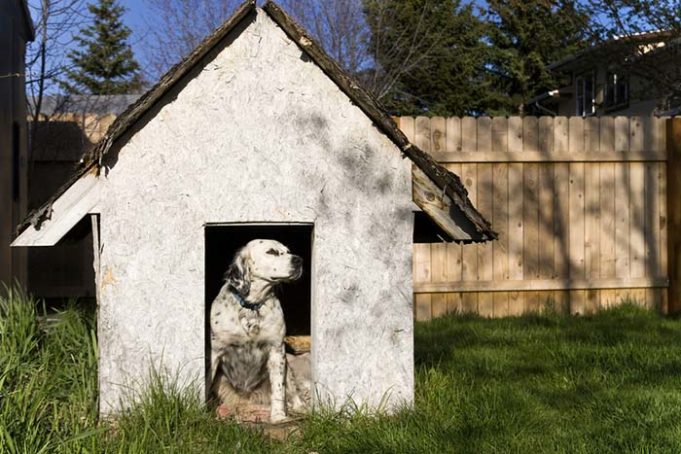While most dogs in the western society are considered pets to be kept indoors in general, the issue of indoors vs outdoors can still come up in a variety of different scenarios. Is your dog supposed to stay indoors with you, or is it more adequate to keep your pooch outside? What's better for the pet, and when is it appropriate to pick one over another?
The question of indoor dogs vs outdoor dogs is further complicated by the fact that most dog breeds seem to want both options at the same time – when you keep them inside, they want to go out. And when you let them out, they want to come back in. How do you deal with that? The answer is simple – find a balance. Dogs love outdoors but they also want to stay indoors with you.
The Nature of Dogs
Looking at the history of dogs, in the nature, canines are outdoor animals; however, years of domestication may have changed that. Dogs are also social animals that want to be with and around their owners. In addition, while dogs aren't “den animals” by definition, they do have tendencies of den animals, so even when they are outdoors, they still want to “go back home” to a den-like place where the rest of the pack is, i.e. your home.
In practice, things are made even more complicated by the fact that different dog breeds have evolved (and have been selected) for completely different things and lifestyles. Some dogs are almost exclusively indoors dogs, while others can’t stand to not be outdoors for any longer than several hours. Other breeds are somewhere in between and love to spend time indoors with you, but also need many hours of outdoors time.
Ultimately, given the social nature of canines, no dog – no matter the breed – should be an exclusively outdoor or indoor dog. Your pet needs mental stimulation and to be around owners to be a healthy animal. While it's okay to let the dog stay longer outside when the temperatures aren't too hot or too cold, bringing the dog home to be around people is also a crucial component of proper pet care and being a responsible dog owner.
Breed Requirements
 The amount of time you can (and sometimes should) let the dog to be outside, playing and exercise, or just enjoying the fresh air, will often depend on the breed. If you're not sure, research your dog's breed requirements further or ask a veterinarian or the place where you've adopted or bought the dog from for more details.
The amount of time you can (and sometimes should) let the dog to be outside, playing and exercise, or just enjoying the fresh air, will often depend on the breed. If you're not sure, research your dog's breed requirements further or ask a veterinarian or the place where you've adopted or bought the dog from for more details.
Some very active dog breeds such as the Bloodhound, the American Water Spaniel, the Vizsla, and many others, need a lot of outdoor time every day. They have high energy requirements and need plenty of exercise.
Owners of said active dogs, particularly those bred for hunting, herding, athletics and working dogs – will need to have a large backyard or enough time to take the dog to a park for running and exercise on top of daily walks. Ignoring breed's energy requirements will likely result in dog's behavioral issues and/or mental health problems.
On the other hand, breeds like Chihuahua, Yorkshire Terrier, and many other small or toy breeds are less outdoorsy types with smaller energy expenditure requirements. This is what makes them more appropriate and popular in cities like New York City where it's hard to find time and space for the dog expend energy on a daily basis.
If you train a small dog with little energy to use an indoor toilet, the time a dog needs to spend outside can be kept to a minimum, which is particularly useful during extremely cold or hot months when these small breeds are in more danger.
Find the Balance
 No matter the breed, however, the middle-ground is the best course of action. Most dogs, whether small, medium or large breeds, enjoy spending time both indoors and outdoors. To have a physically and mentally healthy dog, provide him with the best of both worlds.
No matter the breed, however, the middle-ground is the best course of action. Most dogs, whether small, medium or large breeds, enjoy spending time both indoors and outdoors. To have a physically and mentally healthy dog, provide him with the best of both worlds.
In an ideal situation, when you have a medium or large breed with above average energy, you’ll also have a house with a big, fenced yard. You’ll have a dog kennel and some dog-friendly installations in the yard. You’ll also have more than one dog, so that the two of them can play together.
At the same time, you’ll also let your dogs back in the house whenever they want. You’ll have a wet room or a doggy paw wash station where you’ll be able to easily wash and clean your dogs when they get back in the house. And finally, you’ll have enough place for your dogs to roam and play indoors as well. They’ll have dog beds, toys, and other essential accommodations.
If you do live in a house with a secure backyard, then installing a dog door could be the best possible decision for both you and your pet. This will allow your dogs to go outside when they wish to and play, but also to be home with you whenever they want to rest, without having to bother you about letting them outside and inside.
When It's Not Ideal…
Before you adopt and bring your dog home, make sure that you're bringing a companion suitable for your lifestyle and environment. For example, if you can’t offer a high energy breed enough yard space or enough indoor space, you’ll need to look for the perfect dog breed for your situation. In some cases, you can substitute that with other things such as getting your pet a dog treadmill for extra exercise, but that's not what we'd call ideal.
Some dog owners cannot or do not want to let their dogs spend too much time indoors. Sometimes it's due to lack of space, and other times it’s because they don’t want to let the dog near small children; rarely it’s also because they want their dogs to stay outside as guard dogs, which is the most unacceptable situation among the three. To avoid this, make sure to adopt a breed that's going to fit the lifestyle you currently lead.
Depriving a dog of human contact and keeping him outdoors full-time will usually have detrimental effects on the dog’s psyche. Such dogs often get anti-social and aggressive, and lead lonely, sad and depressed lives. In some countries and U.S. states, you may even be fined and charged for animal cruelty.
Alternatively, another major mistake is getting a dog from a breed that loves to spend time outdoors, and confining it indoors. This can lead to things such as obesity, depression, muscle atrophy, boredom, destructive behavior, aggression, and more.
 In conclusion, picking the best breed for your home and lifestyle is the first and most important step of becoming a responsible dog owner and ensuring a healthy way of life for the pet.
In conclusion, picking the best breed for your home and lifestyle is the first and most important step of becoming a responsible dog owner and ensuring a healthy way of life for the pet.
Always consult with a veterinarian, reputable dog breeder and/or the shelter staff as to what are your living conditions and everyday availability, and ask them to recommend the most suitable dog breed for your situation.
Some want-to-be dog owners have an idea in their head as to what is their favorite dog breed is, and what dog they “simply must have”, but those notions are often based on inadequate criteria. Not every breed will be suitable for you or your lifestyle. Trust your professional canine adviser and look for the dog that will the best match.
READ NEXT: 15 Ways to Entertain Dogs Indoors













